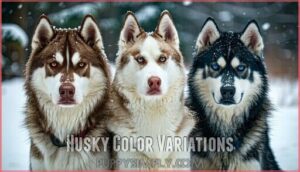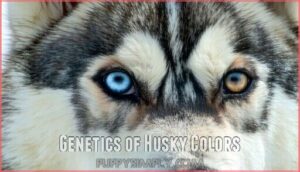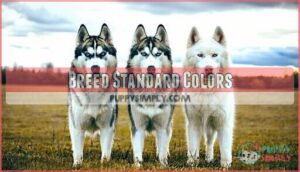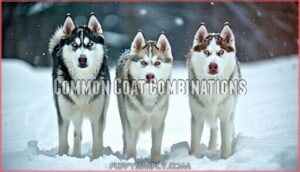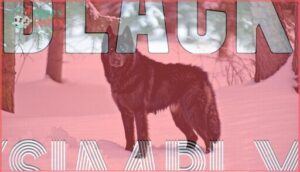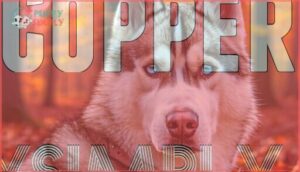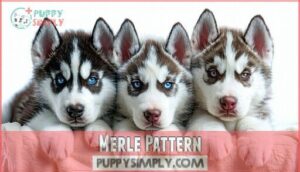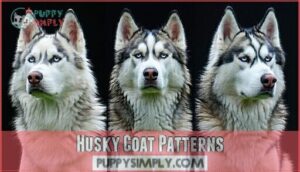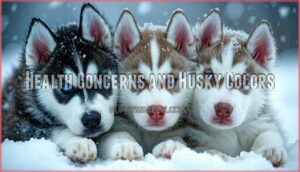This site is supported by our readers. We may earn a commission, at no cost to you, if you purchase through links.
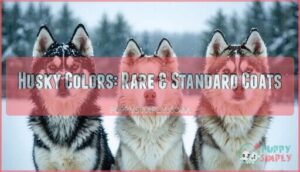 You’re exploring husky colors, and it’s a fascinating world.
You’re exploring husky colors, and it’s a fascinating world.
Husky colors range from standard black and white, grey and white, and red and white, to rare combinations.
You’ll find unique coats like agouti and white, and sable and white.
Understanding husky colors involves genetics, with eumelanin and pheomelanin influencing coat color.
As you learn more about husky colors, you’ll discover the intricacies of their genetics and the various coat patterns that make each husky distinct, setting the stage for a deeper look into the genetics and health concerns associated with these beautiful coats.
Table Of Contents
- Key Takeaways
- Husky Color Variations
- Genetics of Husky Colors
- Standard Husky Colors
- Non-Standard Husky Colors
- Husky Coat Patterns
- Health Concerns and Husky Colors
- Frequently Asked Questions (FAQs)
- What color is a husky coat?
- What color is a Siberian Husky?
- What is black and white husky coloration?
- What color is a red husky?
- What’s the most popular Husky color?
- How do you know ifyour dog is a purebred Husky?
- Do Huskies shed?
- What are the colors of Huskies?
- What is the rarest color of Husky?
- How rare are brown Huskies?
- Conclusion
Key Takeaways
- You’ll find husky colors range from common black and white to rarer agouti and sable combinations.
- You’ll see genetics, specifically eumelanin and pheomelanin, determine a husky’s coat color and pattern.
- You’ll discover non-standard colors like solid black and the merle pattern, but merle can bring health issues.
- You’ll note ethical breeding is vital to avoid health problems linked to certain colors, like deafness with the double merle gene.
Husky Color Variations
You’re about to explore the various Husky color variations, which include a range of standard and non-standard colors.
Discover the stunning world of Husky colors and patterns
As you learn about these colors, you’ll discover the unique characteristics of each, from Agouti and White to Black and White, and how they make each Husky distinct.
Agouti and White
You’re looking at Agouti and White huskies, known for their wolf-like appearance.
- Dark undercoat
- Banded outercoat
- Primitive markings
- Color rarity
- Unique agouti husky features, showcasing stunning husky colors and markings.
Black and White
You’ll notice black and white huskies have variable black intensity, sometimes appearing silver. This pattern distribution creates striking markings contrast, influenced by genetic factors.
The black and white combination is a common husky color, with the black husky and white husky being rarer variations of husky coat colors.
These dogs often require at least five miles of exercise every couple of days, which is a significant requirement.
Grey and White
You’ll find grey and white huskies have varying grey shades with white markings.
Their eye color and nose pigment can differ, showcasing pattern variations within the grey and white husky colors, a common combination in Siberian husky coat colors and markings.
Red and White
In the realm of husky colors, you’ll find red and white. Red intensity ranges from deep brown-red to light copper variations.
Here’s what you might see:
- White mask
- White socks
- Red saddle
- Red ears
- Pattern distribution
Genetic markers play a role. Breeding considerations are key for red husky fur colors. These siberian husky colors aren’t black-based.
Sable and White
You’re exploring Sable and White huskies, a variation from the previously discussed Red and White.
Sable genetics create a unique coat with red or copper undercoat and black-tipped outer hairs, making the sable husky a striking addition to husky colors, with varying Sable markings and breeding considerations.
Some breeders focus on coat color, which can lead to huskies with unique coat variations, resulting in a range of unique appearances due to different breeding considerations.
Genetics of Husky Colors
You’re about to explore the genetics behind husky colors, which is a complex topic.
As you learn about the genetics of husky colors, you’ll discover how genes like Agouti and others influence their coat colors and patterns.
Eumelanin and Pheomelanin
You’re exploring husky genetics, specifically eumelanin and pheomelanin, which control pigment production and color intensity.
These two melanins influence husky colors, with eumelanin producing black and dark brown, and pheomelanin creating red and yellow, affecting breed variations and health implications related to genetics.
Genes Influencing Color Expression
You’ll explore genes influencing color expression, including Eumelanin Expression and Pheomelanin Control, which affect husky genetics and coat genetics.
Determining Color Inheritance and canine genetics, with Agouti Regulation and Piebald Genetics playing key roles in dog genetic and dog coat genetics variations.
Agouti Gene and Silver Coats
You’ll discover the Agouti gene affects husky colors, restricting red and yellow for silver coats.
Key points include:
- Agouti expression
- Silver inheritance
- Ach gene
- Color restriction, influencing husky coat genetics, like sable and agouti husky colors.
Standard Husky Colors
You’re looking at standard husky colors, which include a range of recognized colors and patterns.
As you explore these colors, you’ll find that standard husky colors are defined by the American Kennel Club and include combinations like black and white, grey and white, and red and white.
American Kennel Club Recognized Colors
If you’re curious about husky colors, the American Kennel Club (AKC) has specific guidelines.
These AKC Color Standards influence Color Show Eligibility. Breed Color Acceptance is key!
| Color | AKC Recognition |
|---|---|
| Agouti | Yes |
| Black | Yes |
| Gray | Yes |
| Red | Yes |
Recognized Color Genetics play a role in Color Conformation Judging. These siberian husky colors meet breed standards. Knowing this helps you understand husky colors!
Breed Standard Colors
You’re now looking at breed standard colors, which the American Kennel Club outlines.
AKC Standards dictate husky colors, including rarity and disqualifications.
Showing Huskies requires adherence to these breed standards, considering color preferences and Siberian Husky colors, including eye color, to guarantee a fair competition.
Common Coat Combinations
You’ll find common coat combinations in husky colors, including:
- Black and white
- Grey and white
- Red and white
Showcasing color popularity and pattern prevalence, with markings influence and regional variations affecting breeding impact on siberian husky colors.
Non-Standard Husky Colors
You’re about to explore non-standard Husky colors, which include unique shades like black, brown, and copper.
As you learn about these colors, you’ll discover how they differ from standard colors and what makes them distinct, including the merle pattern.
Black
You’re exploring Black Husky colors.
| Color | Rarity | Genetics |
|---|---|---|
| Solid black | Rare | Melanistic |
| Black mask | Common | Eumelanin |
| Black points | Variable | Dog genetics |
Black husky colors are rare, with solid black being the rarest, due to melanistic genetics.
Like the all white husky, coat color is also determined by inheritance of coat from their parents, which is a result of dog genetics.
Brown
You’ll discover brown huskies have:
- Brown genetics from the liver gene
- Variations in shade
- Rarity due to breed standards
Similarities to red huskies, with brown and white or copper tones, unlike sable, with distinct differences in genetics and appearance.
Copper
You’ll notice Copper variations in husky colors, with Red intensity ranging from deep to light.
Copper genetics play a role in Breeding copper huskies, affecting their rarity.
As a unique aspect of Siberian husky colors, Copper stands out, especially in Red husky dogs, showcasing dog coat colors diversity.
Merle Pattern
You’re learning about the Merle pattern, a genetic trait affecting husky colors.
Merle genetics can lead to health issues, such as eye problems and deafness, making Merle breeding and identification essential to avoid controversies like Double Merle, a dog genetic concern.
Husky Coat Patterns
You’re now exploring husky coat patterns, which can be just as varied as their colors.
Husky coat patterns are as varied as their colors, making each dog unique
As you learn about these patterns, you’ll discover that they include piebald, pinto, agouti, and sable, each with its unique characteristics and genetics.
Piebald Pattern
Beyond solid colors, you’ll find interesting patterns. The piebald husky showcases a dominant color with two other colors appearing as markings.
Here’s what makes the piebald pattern unique:
- It’s influenced by piebald genetics.
- Markings distribution varies.
- Breed standards acknowledge it.
- Pattern rarity depends on husky colors.
This isn’t a Pinto comparison; piebald focuses on specific husky markings.
Pinto Pattern
You explore Pinto Pattern husky colors.
| Color | Pattern | Rarity |
|---|---|---|
| Black | White | Common |
| Grey | White | Uncommon |
| Red | White | Rare |
| Sable | White | Rare |
| Brown | White | Rare |
Pinto genetics influence husky colors, markings.
Agouti Pattern
You’ll recognize the agouti pattern by its wolflike appearance, featuring a dark undercoat and color banding on the outer hairs, with a dominant mask.
Making the agouti husky a rare find with unique husky markings and dog genetic agouti traits influencing husky colors.
Sable Pattern
Understanding the sable pattern involves recognizing red or copper undercoats.
Black-tipped hairs based on red give this unique look.
Sable genetics determine the intensity of the coat.
Sable variations range widely.
Sable breeding requires careful attention.
Sable rarity makes it a sought-after husky color.
Black-tipped hairs are a defining trait.
- It’s like a sunset on fur.
- Sable intensity varies greatly.
- Dog genetic sable is complex.
- Sable markings are beautiful.
Health Concerns and Husky Colors
You’re about to learn how certain husky colors can affect their health.
As you explore the connection between husky colors and health concerns, you’ll discover potential issues like merle pattern health issues and genetic health risks.
Merle Pattern Health Issues
You face Merle gene defects, including deafness, vision impairments, and immune deficiencies.
The Merle pattern is linked to various health issues, making ethical breeding essential to avoid dog genetic concerns, such as Double Merle, and prioritize the dog’s health over desired traits like the merle coat.
Owners often seek products for husky health to support their dogs, addressing concerns related to the merle coat.
Double Merle Condition
You’re dealing with Double Merle Genetics, a severe health issue.
Double merle huskies often suffer blindness, deafness.
Ethical breeding concerns arise, emphasizing prevention strategies and public awareness about husky colors, particularly merle, to mitigate health concerns related to this dog genetic condition, double merle.
Owners can find products for Huskies on various websites.
Genetic Health Risks
You’re considering a husky’s genetic health risks.
Here are key concerns:
- Merle Health
- Double Merle
- Breeding Concerns
- Color-Linked Deafness
- Vision Impairment, due to the merle pattern and dog genetic conditions.
Some owners address specific merle husky needs.
Siberian Husky Club of America Guidelines
You’ll find the Siberian Husky Club of America guidelines prioritize Health Standards and Ethical Concerns.
| Breeding Practices | Health Testing | Color Preferences |
|---|---|---|
| Merle Disqualification | Eye exams | American Kennel Club |
| Responsible breeding | Yearly check-ups | Siberian Husky Club |
| Transparency | Genetic testing | Breed standards |
Frequently Asked Questions (FAQs)
What color is a husky coat?
Imagine a fluffy coat – a husky’s coat comes in various colors, including agouti, black, grey, red, and white.
With distinct patterns like piebald and merle, you’ll love their unique look.
What color is a Siberian Husky?
You’ll see Siberian Huskies in various colors, including agouti, black, grey, red, and sable, often combined with white, showcasing their unique and striking coat patterns and colors naturally.
What is black and white husky coloration?
You’ll notice a black and white husky has a variable black intensity, sometimes appearing silver, with a common pattern featuring a dark undercoat and lighter outer hairs.
What color is a red husky?
You’ll find a red husky has a coat ranging from deep brown-red to light copper, typically without black, with varying shades and intensity of the red coloration.
What’s the most popular Husky color?
You’ll discover the most popular Husky color is black and white, a classic combination, offering a striking appearance with variable black intensity, sometimes appearing silver, making it a timeless favorite.
How do you know ifyour dog is a purebred Husky?
You can verify your dog is a purebred Husky by checking its breed registration, pedigree, and physical characteristics, such as its coat, eyes, and body type, against the breed standard.
Do Huskies shed?
You’ll shed tears over the amount of fur, as Huskies shed heavily, especially during spring and fall, due to their thick double coat.
What are the colors of Huskies?
You’ll find Huskies come in various colors, including agouti, black, grey, red, sable, and white, with distinct patterns like piebald and merle, offering a unique appearance for each dog.
What is the rarest color of Husky?
You’ll notice the rarest Husky color is white, as it’s a result of a genetic condition, making it extremely uncommon and highly prized among breeders and owners alike naturally.
How rare are brown Huskies?
You’re a puzzle piece, and brown Huskies are a rare find, caused by a recessive "liver" gene, making them uncommon but not extremely rare, with a unique solid brown coat.
Conclusion
You’ve learned about the diverse world of husky colors, from standard to rare combinations.
Now, you can appreciate the genetics behind these unique coats, understanding how eumelanin and pheomelanin influence husky colors, making each dog distinct, and valuing the complexity of husky colors.

